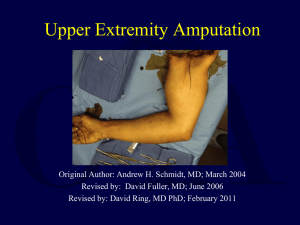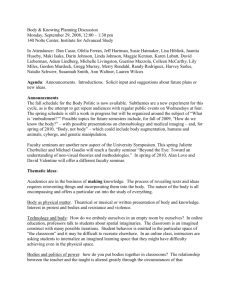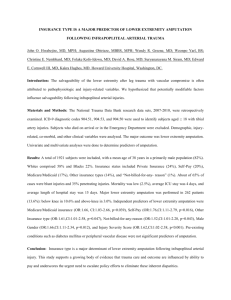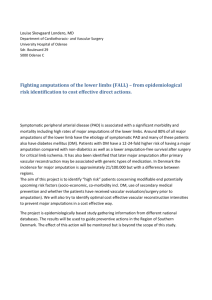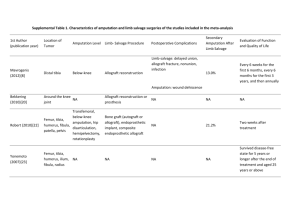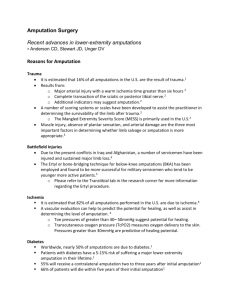Upper Extremity Amputation - Orthopaedic Trauma Association
advertisement
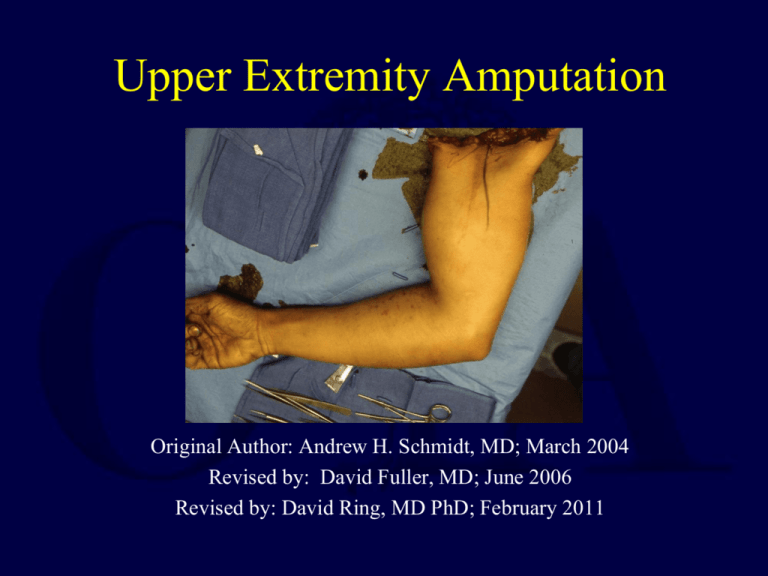
Upper Extremity Amputation Original Author: Andrew H. Schmidt, MD; March 2004 Revised by: David Fuller, MD; June 2006 Revised by: David Ring, MD PhD; February 2011 Amputation: Presentation Goals • Etiology • Techniques • Prosthetics and Rehabilitation Amputation: Etiology • • • • • • • Trauma Burns Peripheral Vascular Disease Malignant Tumors Neurologic Conditions Infections Congenital Deformities Etiology: Trauma • • • • • 90% of Upper Extremity Amputation Male:Female = 4:1 Most Amputations at level of Digit Major Limb Amputations less common Revascularization sometimes possible for incomplete amputation • Replantation sometimes possible for complete amputation Etiology: Trauma Etiology: Tumor Etiology: Infection Etiology: Gangrene/Necrotizing Fasciitis Radiograph: Subcutaneous air throughout arm Etiology:Failed Forearm Vascular Repair after trauma Etiology: Vascular Disease Ischemia after AV Fistula Procedure Etiology: Crush Etiology: Congenital polydactyly Etiology: Infarction associated with IV Drug Abuse Etiology: Scleroderma Amputation: Trauma and Replantation • Candidates for Replantation after Trauma – – – – – – – 1. Thumb 2. Multiple Digits 3. Partial Hand 4. Wrist or Forearm 5. Above Elbow 6. Isolated Digit Distal to FDS insertion 7. Almost any part in child Amputation: Trauma and Replantation • Candidates for Replantation after Trauma – – – – Clean cut Limited crush Limited contamination Acceptable ischemia time • 6 hours with muscle • 24 hours with digit Replantation: Multiple Digits Surgical Technique: Digit Replantation • • • • • • • • • 1. Identify Vessels and Nerves 2. Debride 3. Shorten and fix bone 4. Repair Extensor Tendon 5. Repair Flexor Tendon 6. Repair Arteries 7. Repair Nerves 8. Repair Veins 9. Skin Closure (skin graft if necessary) Amputation: Replantation • Poor Candidates for Replantation – – – – – – – 1. Severely crushed or mangled parts 2. Multiple levels 3. Other serious injuries or diseases 4. Atherosclerotic vessels 5. Mentally unstable 6. > 6 hours ischemic time 7. Severe contamination Amputation: Replantation Mangled and Crushed – Poor Candidate Ectopic “banking” of amputated parts Indicated for extensive injuries with adequate amputated part in setting of contaminated or absent support structures. Recipient sites described- anterior thorax, contralateral arm/leg, groin. High complication rate. Largest and original series described by Marko Godina 1986. Courtesy: J. Higgins Grip strength 80 # (unaffected side 100#) Injured right hand has remained dominant hand Surgical Technique: Major Limb Replantation • Myonecrosis is greater concern than in digit replant • Immediate shunting to obtain arterial inflow may be necessary • High Potassium levels (>6.5 mmol/l ) in venous outflow from amputated part negative prognostic factor • Sequence of repair similar to digit – Identify structures, Debride, Rapid bone stabilization, Vascular repair (artery then veins), Tendons and Nerves Upper vs Lower Limb • Upper extremity nonweightbearing – – – – – Less durable skin acceptable Decreased sensation better tolerated Joint deformity better tolerated Late amputations rare Transplants now being performed Major Limb Replantation Include Surgical Prep of Legs for vascular and nerve grafts Rapid Bone Stabilization Ready for Anastomosis UE traumatic amputation may be associated with life threatening hemorrhage Courtesy of T. Higgins, M Dietch Aggressive resuscitation and limb repair Courtesy of T. Higgins, M. Dietch Amputation: Major Limb Replantation Outcomes • >2/3 survival rate • Can be a life threatening undertaking • Multiple Surgeries often required – Late Nerve, Bone, Tendon Surgeries • Function of major upper extremity replantations even though poor can be superior to prosthetic function Outcomes: Major Limb Replantation • Comparison of functional results of replantation versus prosthesis in a patient with bilateral arm amputation Peacock, Tsai, CORR, 1987 • Major amputation of the UE: Functional Results after replantation/revascularization in 47 cases Daoutix et al, Acta Orthop Scand, 1995 • Major Replantation versus revision amputation and prosthetic fitting in the upper extremity: a late functional outcome study Graham et al, J Hand Surg, 1998 Amputation: Technique • Preservation of functional residual limb length balanced with • Soft tissue reconstruction to provide a wellhealed, nontender, physiologic residual limb Technique: Determination of Level • • • • • • • Zone of Injury (trauma) Adequate margins (tumor) Adequate circulation (vascular disease) Soft tissue envelope Bone and joint condition Control of infection Nutritional status Tumor Forequarter Amputation Necrotizing Fasciitis Emergent Open Shoulder Disarticulation Trauma High Transhumeral Nerves Avulsed from High in Plexus Failed Vascular Repair Transradial Levels of Amputation • Wrist Disarticulation vs. Transradial – Disarticulation offers potential of better active pronation and suppination of forearm – Transradial often difficult to transmit rotation through prosthesis – Disarticulation poor aesthetically – Disarticulation more difficult to fit prosthetic – Transradial needs to be done 2 cm or more proximal to joint to allow prosthetic fitting – Transradial usually favored Levels of Amputation • Transhumeral vs. Elbow Disarticulation – Adults: Elbow disarticulation allows enhanced suspension and rotation control of prosthesis however retention of full length precludes use of prosthetic elbow. Long transhumeral favored – Pediatrics: Transhumeral amputation results in high incidence of bony overgrowth. Elbow disarticulation is level of choice. Humeral growth slowed after trauma. Levels of Amputation • Preservation of Elbow function is a priority – Consider replantation/salvage of parts to maintain elbow function – 4-5 cm of proximal ulna necessary for elbow function – For very proximal amputations, it may be necessary to attach bicep tendon to ulna Techniques • Debridement of all Nonviable tissue and foreign material • Several debridements may be required • Primary wound closure often contraindicated • High voltage, electrical burn injuries require careful evaluation because necrosis of deep muscle may be present while superficial muscles can remain viable Techniques • Nerve: Prevent neuroma formation – Draw nerve distally, section it, allow it to retract proximally • Skin: – – – – Opportunistic flaps Rotation flaps Tension free Skin grafts Techniques • Bone: – Choose appropriate level – Smooth edges of bone – Narrow metaphyseal flare for some disarticulations Postoperative Dressing: – Soft – Rigid Techniques • Goals of Postoperative Management – – – – – Prompt, uncomplicated wound healing Control of edema Control of Postoperative pain Prevention of joint contractures Rapid rehabilitation Technique: Example 30 yo male, assault Technique: Example ray amputation Be sure to identify all injuries and treat Technique: Example 1 year postop Technique: Example debridement and preservation of viable structure Technique:Example Late reconstruction after initial amputation surgery Rehabilitation and Prosthetics Rehabilitation • • • • • • 1. Residual Limb Shrinkage and Shaping 2. Limb Desensitization 3. Maintain joint range of motion 4. Strengthen residual limb 5. Maximize Self reliance 6. Patient education: Future goals and prosthetic options Psychological Adaptation • Amputation represents loss of function, sensation and body image • Psychological response is determined by many variables – – – – – – Psychosocial/Age Personality Coping Strategies Economic/Vocational Health Reason for amputation Psychological Adaptation • Up to 2/3 of amputees will manifest postoperative psychiatric symptoms – – – – – – Depression Anxiety Crying spells Insomnia Loss of appetite Suicidal ideation Psychological Adaptation: Stages • 1. Preoperative – Tumor, Vascular Disease, Chronic Infection – Support Groups • 2. Immediate Postoperative – Hours to days – Safety, Pain, Disfigurement • 3. In-Hospital Rehabilitation • 4. At-Home Rehabilitation In-Hospital Rehabilitation • Initial: concerns about safety, pain, disfigurement • Later: emphasis shifts to social reintegration and vocational adjustments • Grief Response: – 1. “numbness” or denial – 2. yearning for what is lost – 3. Disorganization: all hope is lost for recovery of lost part – 4. Reorganization Management of Amputee • • • • • • Preparation Good Surgical Technique Rehabilitation Early Prosthetic Fitting Team Approach Vocational and Activity Rehabilitation Prosthetics • Passive – Cosmetic • Body Powered – Harnesses and cables • Myoelectric – Surface EMG – Activation delay • Neuroprosthetics – Investigational at this time Rehabilitation Suggested timeline for transradial amputation • 1-14 days: immediate postop prosthesis • 2-4 weeks: training body powered prosthesis • 6-12 weeks: definitive body powered prosthesis • 6-12 weeks: training electronic prosthesis • 4-6 months: definitive electronic prosthesis Acknowledgement Review Articles for Reference 1: Tintle SM, Baechler MF, Nanos GP 3rd, Forsberg JA, Potter BK. Traumatic and trauma-related amputations: Part II: Upper extremity and future directions. J Bone Joint Surg Am. 2010 Dec 15;92(18):2934-45. Review. PubMed PMID: 21159994. 2: Muilenburg TB. Prosthetics for pediatric and adolescent amputees. Cancer Treat Res. 2009;152:395-420. Review. PubMed PMID: 20213404. 3: Jones NF, Schneeberger S. Arm transplantation: prospects and visions. Transplant Proc. 2009 Mar;41(2):476-80. Review. PubMed PMID: 19328907. 4: Buncke GM, Buncke HJ, Lee CK. Great toe-to-thumb microvascular transplantation after traumatic amputation. Hand Clin. 2007 Feb;23(1):105-15. Review. PubMed PMID: 17478257. 5: Hanel DP, Chin SH. Wrist level and proximal-upper extremity replantation. Hand Clin. 2007 Feb;23(1):13-21. Review. PubMed PMID: 17478249. Review Articles for Reference 6: Tamurian RM, Gutow AP. Amputations of the hand and upper extremity in the management of malignant tumors. Hand Clin. 2004 May;20(2):vi, 213-20. Review. PubMed PMID: 15201025. 7: Moran SL, Berger RA. Biomechanics and hand trauma: what you need. Hand Clin. 2003 Feb;19(1):17-31. Review. PubMed PMID: 12683443. 8: Breidenbach WC 3rd, Tobin GR 2nd, Gorantla VS, Gonzalez RN, Granger DK. A position statement in support of hand transplantation. J Hand Surg Am. 2002 Sep;27(5):760-70. Review. PubMed PMID: 12239664. 9: Shatford RA, King DH. The treatment of major devascularizing injuries of the upper extremity. Hand Clin. 2001 Aug;17(3):371-93. Review. PubMed PMID: 11599207. If you would like to volunteer as an author for the Resident Slide Project or recommend updates to any of the following slides, please send an e-mail to ota@ota.org Return to Upper Extremity Index
